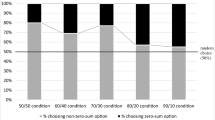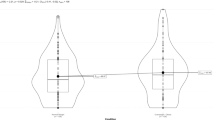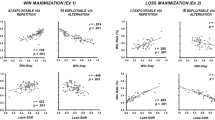Abstract
Background:
Employment disparities are known to exist between lean and corpulent people, for example, corpulent people are less likely to be hired and get lower wages. The reasons for these disparities between weight groups are not completely understood. We hypothesize (i) that economic decision making differs between lean and corpulent subjects, (ii) that these differences are influenced by peoples’ blood glucose concentrations and (iii) by the body weight of their opponents.
Methods:
A total of 20 lean and 20 corpulent men were examined, who performed a large set of economic games (ultimatum game, trust game and risk game) under euglycemic and hypoglycemic conditions induced by the glucose clamp technique.
Results:
In the ultimatum game, lean men made less fair decisions and offered 16% less money than corpulent men during euglycemia (P=0.042). During hypoglycemia, study participants of both weight groups accepted smaller amounts of money than during euglycemia (P=0.031), indicating that a lack of energy makes subjects to behave more like a Homo Economicus. In the trust game, lean men allocated twice as much money to lean than to corpulent trustees during hypoglycemia (P<0.001). Risk-seeking behavior did not differ between lean and corpulent men.
Conclusion:
Our data show that economic decision making is affected by both, the body weight of the participants and the body weight of their opponents, and that blood glucose concentrations should be taken into consideration when analyzing economic decision making. When relating these results to the working environment, the weight bias in economic decision making may be also relevant for employment disparities.
This is a preview of subscription content, access via your institution
Access options
Subscribe to this journal
Receive 12 print issues and online access
$259.00 per year
only $21.58 per issue
Buy this article
- Purchase on Springer Link
- Instant access to full article PDF
Prices may be subject to local taxes which are calculated during checkout



Similar content being viewed by others
References
Puhl RM, Heuer CA . The stigma of obesity: a review and update. Obesity (Silver Spring) 2009; 17: 941–964.
Puhl R, Wharton C, Heuer C . Weight bias among dietetics students: implications for treatment practices. J Am Diet Assoc 2009; 109: 438–444.
Sikorski C, Luppa M, Brahler E, Konig HH, Riedel-Heller SG . Obese children, adults and senior citizens in the eyes of the general public: results of a representative study on stigma and causation of obesity. PLoS One 2012; 7: e46924.
Klesges RC, Klem ML, Hanson CL, Eck LH, Ernst J, O'Laughlin D et al. The effects of applicant's health status and qualifications on simulated hiring decisions. Int J Obes 1990; 14: 527–535.
Cawley J . The impact of obesity on wages. J Hum Resources 2004; XXXIX: 451–474.
Tunceli K, Li K, Williams LK . Long-term effects of obesity on employment and work limitations among U.S. Adults, 1986 to 1999. Obesity (Silver Spring) 2006; 14: 1637–1646.
Brunello G, D'Hombres B . Does body weight affect wages? Evidence from Europe. Econ Hum Biol 2007; 5: 1–19.
Garcia J, Quintana-Domeque C . Obesity, employment and wages in Europe. Adv Health Econ Health Serv Res 2007; 17: 187–217.
Campanha C, Minati L, Fregni F, Boggio PS . Responding to unfair offers made by a friend: neuroelectrical activity changes in the anterior medial prefrontal cortex. J Neurosci 2011; 31: 15569–15574.
Kubota JT, Li J, Bar-David E, Banaji MR, Phelps EA . The price of racial bias: intergroup negotiations in the ultimatum game. Psychol Sci 2013; 24: 2498–2504.
Ma Q, Hu Y . Beauty matters: social preferences in a three-person ultimatum game. PLoS One 2015; 10: e0125806.
Güth W, Tietz R Auctioning ulitmatum bargaining positions-how to act rational if decisions are unacceptable? In: Scholz RW (ed). Current Issues in West German Decision Research. Verlag Peter Lang: Frankfurt, Germany, 1986; 173–185.
Xin Z, Liu G . Homo economicus belief inhibits trust. PLoS One 2013; 8: e76671.
Camerer C, Thaler RH . Anomalies ultimatums, dictators and manners. J Econ Perspect 1995; 9: 209–219.
Berg J, Dickhaut J, McKabe K . Trust, reciprocity, and social history. Games Economic Behav 1995; 10: 122–142.
Pahlke J, Strasser S, Vieider FM . Responsibility Effects in Decision Making under Risk. Munich Discussion Paper No. 2010-37. 2010. München, Ludwigs-Maximilians-Universität München.
Pahlke J, Strasser S, Vieider FM . Responsibility effects in decision making under risk. J Risk Uncertainty 2015; 51: 125–146.
Harle KM, Sanfey AG . Incidental sadness biases social economic decisions in the ultimatum game. Emotion 2007; 7: 876–881.
Mellers BA, Haselhuhn MP, Tetlock PE, Silva JC, Isen AM . Predicting behavior in economic games by looking through the eyes of the players. J Exp Psychol Gen 2010; 139: 743–755.
Riepl K, Mussel P, Osinsky R, Hewig J . Influences of state and trait affect on behavior, feedback-related negativity, and P3b in the ultimatum game. PLoS One 2016; 11: e0146358.
Zhang HJ, Sun D, Lee TM . Impaired social decision making in patients with major depressive disorder. Brain Behav 2012; 2: 415–423.
Destoop M, Schrijvers D, De GC, Sabbe B, De Bruijn ER . Better to give than to take? Interactive social decision-making in severe major depressive disorder. J Affect Disord 2012; 137: 98–105.
Harle KM, Allen JJ, Sanfey AG . The impact of depression on social economic decision making. J Abnorm Psychol 2010; 119: 440–446.
Verdejo-Garcia A, Verdejo-Roman J, Rio-Valle JS, Lacomba JA, Lagos FM, Soriano-Mas C . Dysfunctional involvement of emotion and reward brain regions on social decision making in excess weight adolescents. Hum Brain Mapp 2014; 36: 226–237.
Branas-Garza P, Espin AM, Lenkei B . BMI is not related to altruism, fairness, trust or reciprocity: experimental evidence from the field and the lab. Physiol Behav 2016; 156: 79–93.
Gailliot MT, Baumeister RF . The physiology of willpower: linking blood glucose to self-control. Pers Soc Psychol Rev 2007; 11: 303–327.
Anderson C, Dickinson DL . Bargaining and trust: the effects of 36- h total sleep deprivation on socially interactive decisions. J Sleep Res 2010; 19 (1 Pt 1): 54–63.
Mancini A, Betti V, Panasiti MS, Pavone EF, Aglioti SM . Suffering makes you egoist: acute pain increases acceptance rates and reduces fairness during a bilateral ultimatum game. PLoS One 2011; 6: e26008.
Symmonds M, Emmanuel JJ, Drew ME, Batterham RL, Dolan RJ . Metabolic state alters economic decision making under risk in humans. PLoS One 2010; 5: e11090.
Wang XT, Dvorak RD . Sweet future: fluctuating blood glucose levels affect future discounting. Psychol Sci 2010; 21: 183–188.
Pudel V, Westenhoefer J . Fragebogen zum Eßverhalten: Handanweisung. Hogrefe: Goettingen, Germany 1989.
Lustman PJ, Clouse RE, Griffith LS, Carney RM, Freedland KE . Screening for depression in diabetes using the Beck Depression Inventory. Psychosom Med 1997; 59: 24–31.
Selten R . Die Strategiemethode zur Erforschung des eingeschränkt rationalen Verhaltens im Rahmen eines Oligopolexperiments. In: Sauerman H (ed). Beiträge zur experimentellen Wirtschaftsforschung. J.C.B. Mohr (Paul Siebeck). Tübingen 1967. 136-138.
Schulz P, Schlotz W, Becker P . Trier Inventar zum Chronischen Stress (TICS). Hogrefe: Göttingen, Germany 2004.
Bechler C, Green L, Myerson J . Proportion offered in the dictator and ultimatum games decreases with amount and social distance. Behav Processes 2015; 115: 149–155.
Hu J, Cao Y, Blue PR, Zhou X . Low social status decreases the neural salience of unfairness. Front Behav Neurosci 2014; 8: 402.
Peters A, Schweiger U, Pellerin L, Hubold C, Oltmanns KM, Conrad M et al. The selfish brain: competition for energy resources. Neurosci Biobehav Rev 2004; 28: 143–180.
Bos MW, Dijksterhuis A, Van Baaren R . Food for thought? Trust your unconscious when energy is low. J Neurosci Psychol Eco 2012; 5: 124–130.
Levitt SD, List JA . Economics. Homo economicus evolves. Science 2008; 319: 909–910.
Orquin JL, Kurzban R . A meta-analysis of blood glucose effects on human decision making. Psychol Bull 2015; 142: 546–567.
Sutterlin S, Herbert C, Schmitt M, Kubler A, Vogele C . Overcoming selfishness: reciprocity, inhibition, and cardiac-autonomic control in the ultimatum game. Front Psychol 2011; 2: 173.
Jones A, McMillan MR, Jones RW, Kowalik GT, Steeden JA, Deanfield JE et al. Adiposity is associated with blunted cardiovascular, neuroendocrine and cognitive responses to acute mental stress. PLoS One 2012; 7: e39143.
Kubera B, Hubold C, Zug S, Wischnath H, Wilhelm I, Hallschmid M et al. The brain's supply and demand in obesity. Front Neuroenerget 2012; 4: 4.
Sanfey AG, Rilling JK, Aronson JA, Nystrom LE, Cohen JD . The neural basis of economic decision-making in the ultimatum game. Science 2003; 300: 1755–1758.
Altabe M . Ethnicity and body image: quantitative and qualitative analysis. Int J Eat Disord 1998; 23: 153–159.
Paeratakul S, White MA, Williamson DA, Ryan DH, Bray GA . Sex, race/ethnicity, socioeconomic status, and BMI in relation to self-perception of overweight. Obes Res 2002; 10: 345–350.
Acknowledgements
This study is a follow-on project of the Clinical Research Group KFO-126 supported by the German Research Foundation. The German Research Foundation had no role in the study design; in the collection, analysis and interpretation of data; in the writing of the report; and in the decision to submit the article for publication. All researchers are independent from funders.
Author information
Authors and Affiliations
Corresponding author
Ethics declarations
Competing interests
The authors declare no conflict of interest.
Additional information
Supplementary Information accompanies this paper on International Journal of Obesity website
Supplementary information
Rights and permissions
About this article
Cite this article
Kubera, B., Klement, J., Wagner, C. et al. Differences in fairness and trust between lean and corpulent men. Int J Obes 40, 1802–1808 (2016). https://doi.org/10.1038/ijo.2016.134
Received:
Revised:
Accepted:
Published:
Issue Date:
DOI: https://doi.org/10.1038/ijo.2016.134



